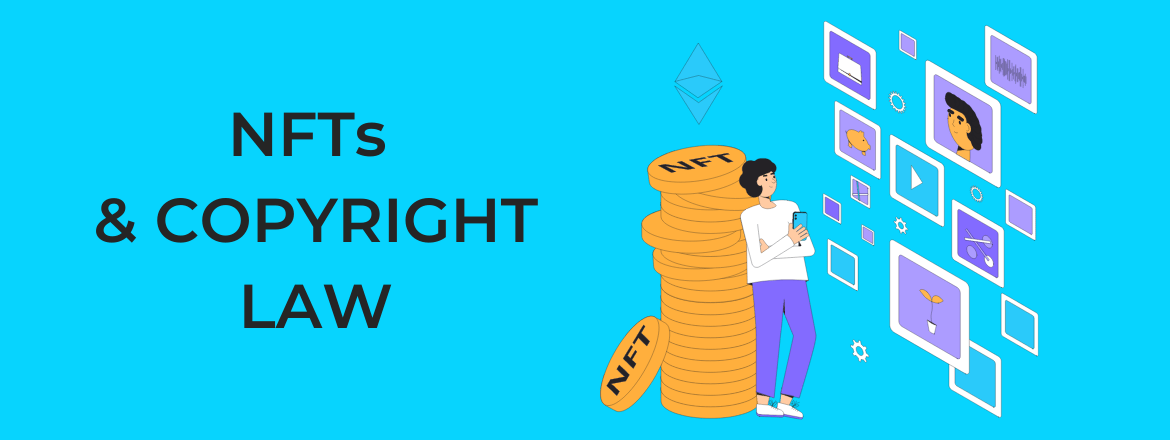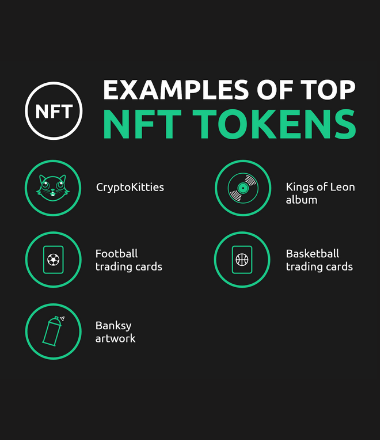All you need to know about Non-fungible Tokens and Copyright Law

Table of Contents
What is a Non-Fungible Token (NFT)?
A non-fungible token (NFT) is a unique digital asset that represents ownership of a distinct item or piece of content, such as a piece of art, a collectible, or a piece of music. Unlike fungible tokens, such as cryptocurrencies, NFTs cannot be exchanged for an equal value and are indivisible. NFTs are usually stored on a blockchain, making them secure, transparent, and easily transferable.
In addition, NFTs bridge the digital/blockchain world and the 'real world' thanks to the real-world value and application of the assets. For instance, NFTs are used widely for loyalty programs like air miles, creating online gaming experiences, and digital rewards. NFTs can also be used as digital tokens representing real-world assets like real estate, precious metals, cars, and even equity or bonds. In this case, these underlying assets can easily be traded avoiding some of the bottlenecks represented by traditional markets and financial systems.
The world of cryptocurrency, crypto-art, and NFTs can often seem cryptic. For instance, NFTs can represent real-world assets or serve as certificates of authenticity. While this proves legal ownership, how does it affect intellectual property rights? For copyrights, specifically, NFTs are a legal grey area, due to a number of reasons worth exploring.
Non-fungible tokens (NFTs) have gained mainstream interest at an accelerated rate over the past year. Everyone is either buying, selling, or endorsing an NFT. This ranges from top Olympic athletes like Usain Bolt, to movie stars like Reese Witherspoon, and even the world of K-Pop has not been left untouched. Global music sensation BTS recently announced a partnership with Upbit cryptocurrency exchange to launch their own NFTs.
However, it seems that digital assets are as confusing as they are popular. While NFTs grant their owners certain privileges, do these extend to copyright? What intellectual property rights, if any, can an NFT owner or creator legally claim? To answer these questions, it is important to first understand how exactly an NFT works.
How do NFTS Work?
As previously mentioned, NFTs are built on blockchains like Bitcoin (BTC), Ethereum (ETH), Binance Smart Chain (BSC), and Tezos to name a few. To understand how NFTs work, it is important to define some of the NFT technical terms.
A non-fungible token is a digital asset created on a blockchain using basic to complex coding depending on several factors.
Defining Key NFT Terms
- Non-Fungible
Fungibility refers to assets that are uniform, interchangeable, divisible, and very liquid. For example, fiat currency or money is a fungible asset. A dollar bill can easily be exchanged for another dollar bill, coins of the same value, or even equivalent currency. There is also a ready market and high demand for fungible assets which makes them very liquid or easy to dispose of.
Non-fungibility, on the other hand, refers to unique, illiquid, and indivisible assets. In this case, much of the value of an NFT lies in the fact that it is one-of-a-kind with the added benefit of an incorruptible ‘digital certificate’ of authenticity stored on the underlying blockchain. Non-fungibility is one of the characteristics that make NFTs so expensive. However, NFT fractionalization is a new concept being introduced by blockchains like Unicly but is yet to gain popularity. If successful, fractionalization will help make NFTs more affordable.
Another reason why NFTs are expensive is due to the cost of minting or creating NFTs on blockchains. This is because Ethereum, the most popular network for NFTs, is often congested leading to high minting fees.
- Token
The term token refers to a type of cryptocurrency that is created or exists on a blockchain. On the one hand, crypto coins like Bitcoin and Ether (the token or cryptocurrency of the Ethereum blockchain) are inherent to their blockchains and are usually released through mining. On the other hand, tokens can be created or minted by anyone using the blockchain. To create tokens, blockchain users use coding, smart contracts, or dApps. For instance, smart contracts are used to convert ERC-20 or ERC-721 tokens into NFTs on the Ethereum blockchain. Also, the ERC721 token, which is the NFT standard for Ethereum, has an embedded traceable function.
NFTs like any other token or coin can be listed and traded on exchanges. Platforms like OpenSea, Mintable, Rarible, and Crypto.com/NFT enable the easy exchange of NFTs. To buy NFTs you can either use your credit/debit card or existing crypto holdings depending on the platform you choose to use.
- Blockchain
A blockchain is a series of connected blocks of data added over time to create a digital public ledger. Each block of data contains publicly visible records of transactions occurring on the blockchain. Notably, these transactions are verified before they can be added to the block in a process called mining. Crypto miners use “nodes” scattered across the globe to verify blockchain transactions. The global dispersion of nodes is why blockchains are decentralized with no point of weakness, regulation, or attack. It’s also why it is “impossible” to switch off a blockchain while also making NFT copyright regulation difficult.
The functionality of blockchains makes NFTs traceable and secure as they are embedded in the very makeup of the blockchain. In addition, traditional blockchains like Bitcoin cannot be edited or otherwise manipulated. However, the decentralized nature of blockchain has thus far made it difficult to regulate crypto and other assets dependent on blockchain technology. This is one of the reasons why enforcing copyright rules on NFTs is so difficult. Although blockchain ledger is public, it is almost impossible to attribute ownership unless the creator or owner wants to be traceable.
Under the Paris Convention, copyright is attributed to the creator upon creation. However, the type of people that utilize blockchain technology often desires anonymity. This makes it difficult to broadly enforce copyright and other intellectual property protection which require users to disclose their wallets and transaction records in order to prove ownership.
- Wallet
An NFT or crypto wallet is where you can keep your coins and tokens. To keep your NFTs safe, crypto wallets use private keys or encrypted passwords. Without these keys the wallets are inaccessible and in most cases, the assets contained in the wallet cannot be retrieved.
In addition, only wallets on some crypto exchanges require the user to sign up or fill out a KYC (know your customer). South Korea, for example, made it mandatory for crypto exchanges to track their user identities and transactions for tax and anti-money laundering purposes. Otherwise, most blockchain wallets are completely anonymous with the wallet key ID being the only thing that can be traced.
Crypto wallets can also be hot or cold with hot wallets being online and cold wallets offline.


How NFTs started
NFTs started in 2012-13 as "colored coins" on the Bitcoin blockchain. Similar to NFTs, colored coins also represent real-world assets. In 2016, Jason Rosenstein and Louis Parker hosted the first-ever Rare Digital Art Festival where NFTs were auctioned for the first time. This event gave birth to CryptoArt with creators able to submit and sell their artwork for the first time. In turn, this was the first-time digital art demonstrated that it has an intrinsic value.
Today, the NFT market capitalization is estimated to be worth about 1.4 billion US dollars, according to Statista. The highest selling NFT, recorded to date, is an NFT by CryptoPunk dubbed Crypto Punk 9998. The NFT sold for a staggering 124,457.07 Ether which was worth about $530 million at the time of the sale. NFT 9998 beat the record previously set by the Beeples’ digital artwork which sold for about $69 million earlier this year (March 2021).
NFTs and Copyrights
The unique nature of NFTs means there is a need for creators to gatekeep their collections from copycats by using intellectual property protection. However, this protection is limited due to the lack of regulatory clarity for digital assets and cryptocurrency specifically.
Despite the lack of regulation, NFTs offer a few advantages in comparison to more traditional assets. For instance, NFTs are more liquid and easier to transfer in comparison to their real-world counterparts. With the recent rise in NFT adoption, even more, digital marketplaces have sprung up catering to a diverse user base and ready market. In addition, new NFT platforms launch daily with the main consensus being making the digital assets more accessible, enhancing user experience, and reducing transaction costs. However, NFT ownership still does not automatically mean copyright ownership like with a real-world asset.
Copyright ownership grants the holder exclusive rights to the use, reproduction, distribution, public display, and performance of the underlying creative asset. For example, US copyright laws grant that only the copyright holder has the exclusive right to turn original work into an NFT. CryptoPunk, an NFT project with 10,000 unique NFTs by Larva Labs, submitted a copyright claim against an NFT platform called Foundation.
CryptoPunk claims that Foundation is displaying NFTs that are part of its collection. The NFTs in question were submitted to Foundation by Ryder Ripple who in turn claims to be their creator. While the claim is still ongoing, it does point to the challenge posed by the lack of clear copyright guidelines in the NFT space. The challenge extends to reproductions and derivative works which substantially increase the scope of potential infringement.
At the same time, NFTs enable creators to claim royalties on the subsequent resale of their work, something that does not have widespread acceptance under traditional market conditions. In addition, marginalized creators like meme creators are able to cash in on their viral memes through NFTs. Meme creators that have benefited from NFTs include Zoe Roth, popularly known for her ‘Disaster Girl’ meme. The meme NFT sold for US$500,000 in May 2021.
However, meme NFTs do not limit the use or distribution of the meme itself. It simply means that meme creators sell the ‘original meme’.
Conclusion
NFTs, like blockchain and cryptocurrency, do not neatly fit into traditional laws and regulations, including copyright. This is partly because blockchain technology was created with the intention of disrupting traditional systems. The other reason is that blockchain technology and NFTs still lack mainstream adoption. As more and more people begin owning and using NFTs, regulatory authorities will be forced to take a more active approach to protect creator or ownership rights through copyrights and other intellectual property protection.
In the meantime, legal counsel from intellectual property experts like Abou Naja Intellectual Property will help you ensure that you are adequately protected. To learn more about intellectual property protection and copyrights, please contact us at [email protected].






